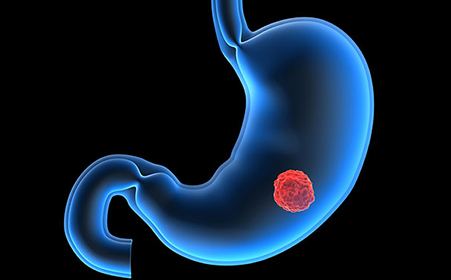SCI论文(www.lunwensci.com):
摘要:胃癌是全球高发的恶性肿瘤之一,其致病机制复杂,涉及多种因素。其中,部分胃癌的病发与EB病毒感染相关,其发病机制具有独特的分子生物学特征,国内外学者对此进行了持续深入的研究,并且提出多个学说。本文就EB病毒相关胃癌病理机制方面的最新研究进展作一综述。
关键词:胃癌;EB病毒;EBVaGC
本文引用格式:侯俊芳,马玉滨.EB病毒相关胃癌致病机制研究进展[J].世界最新医学信息文摘,2019,19(99):148-149.
Research Progress in Pathogenesis of Epstein-Barr Virus-associated Gastric Cancer
HOU Jun-fang,MA Yu-bin*
(Affiliated Hospital of Qinghai University,Xining Qinghai)
ABSTRACT:Gastric cancer is one of the most common malignant tumors in the world.Its pathogenic mechanism is complex and involves many factors.The pathogenesis of some gastric cancer may be related to Epstein-Barr virus infection,which has unique molecular biological characteristics.Domestic and foreign scholars have conducted in-depth research on it and put forward several theories.This article reviews the latest research progress in the pathogenesis of Epstein-Barr virus-associated gastric cancer.
KEY WORDS:Gastric cancer;Epstein-Barr virus;EBVaGC
0引言
2018年3月,全球癌症生存调查结果显示韩国和日本胃癌患者的5年生存率超过60%,我国部分地区胃癌生存数据与此相似,但我国整体胃癌患者5年生存率仍低于40%[1],形势不容乐观。胃癌的致病机制复杂,涉及体内体外多种因素。上世纪90年代Masayoshi等[2]将存在EB病毒感染(Epstein-Barr Virus,EBV)的胃癌定义为EBV相关胃癌(EBV-associatedgastric carcinoma,EBVaGC),其余为EBV非相关胃癌(EBV-negative gastric carcinomas,EBVnGC)。2014年《自然》杂志报道的一项癌症基因组图谱(The Cancer Genome Atlas,TCGA)计划中提出了新的胃癌分子分型:EBV感染型、微卫星不稳定型、基因组稳定型和染色体不稳定型[3]。随着国内外学者对EBVaGC的持续深入研究,发现EBV感染下一些宿主基因突变与产物表达与胃癌的发生及发展密切相关,相关理论层出不穷,但尚未阐明其确切分子机制。因此,需要深入分析EBVaGC发生发展过程中EBV和宿主细胞基因突变之间的关系,以有效防治EBVaGC的病发。
1EBVaGC相关基因表达及分子机制
EBV感染形式根据其所处不同状态分为增殖裂解性感染和潜伏性感染。通过经口途径原发感染建立的一种终生的病毒携带状态,称为潜伏感染,它在细胞核内作为附加体持续存在。在其潜伏期内,EBV组成性地表达一组有限的潜在性基因产物,包括潜伏性膜蛋白(LMP1,2A和2B)、EBV核抗原(EBNAs 1,2,3A,3B,3C和EBNA-LP)[4],EBV编码的小RNA(EBERs1和2)和来自BamHI-A右侧转录物的40个microRNA(BART)[5]。根据这些基因产物的组合方式,分为四种潜伏期模式:潜伏期Ia,Ib,II和III[6]。EBVaGC属于潜伏期I,主要表达EBER,BART和EBNA1[6],潜伏期Ia和Ib主要由LMP2A的缺失或存在予以区分,超过50%的EBVaGC病例表达了LMP2A[7]。
1.1LMP2A
EBV一旦感染人胃上皮细胞,就进入潜伏期,导致宿主全基因组甲基化和细胞信号通路失调。有研究表明,LMP2A可诱导宿主DNA甲基转移酶1(DNMT1)[8]或DNMT3b[9]过表达并启动全基因组甲基化,这是EBV诱导胃癌发生的关键机制。此外,LMP2A参与调控多个细胞通路。LMP2A可调节升高裂变蛋白质1(Drp1)使胃癌、乳腺癌细胞中线粒体分裂升高;LMP2A通过激活Totch通路增加线粒体分裂,使融合周期不平衡,增强裂变,促使上皮细胞转移[10];通过蛋白酶体下调早期凋亡介质BIM,LMP2A介导了ERK通路的激活和细胞的抗失巢凋亡,与EBV相关的上皮恶性肿瘤的发生直接相关[11]。然而,也有研究表明,LMP2A通过TWIST、YB-1参与的通路下调HER2的表达,有助于改善胃癌患者的预后[12]。
1.2BARF-1
导致胃癌发生的特定EBV癌基因是否存在,目前仍在研究中。但是不同的细胞类型可能对EBV癌基因的反应是不同的。EBV BamHI-A右侧第1框(BARF-1)基因编码具有细胞转化和促有丝分裂特性的分泌蛋白,其在EBVaGC的潜伏期内持续表达[13],发挥多种生理功能。在啮齿动物细胞系中,BARF-1可诱导细胞凋亡,但在人胃上皮细胞模型中尚未观察到此过程[14];在EBV感染胃癌细胞中,BARF-1通过上调NF-κB和cyclin-D1的表达增强细胞增殖能力[13];同时,BARF-1可降低细胞周期抑制剂p21的表达,刺激EBV感染的胃癌细胞,从而促进EBV诱导的癌症进展[13];相应的,Turrini等人通过制备BARF-1单克隆抗体,与BARF-1结合并诱导抗体依赖性细胞毒性,实现了对EBV阳性细胞的直接抗肿瘤作用,同时也限制BARF-1分子的促有丝分裂活性[15];通过线粒体途径调节Bcl-2/Bax比例,BARF-1的表达下调,可诱导癌细胞凋亡[16]。此外,BARF-1的表达下调,不仅可以使PARP蛋白裂解和减小细胞线粒体膜电位,而且可促进细胞色素C从线粒体释放到细胞质中形成细胞凋亡复合体,加速胃癌细胞凋亡,这一过程依赖Caspase信号通路[17]。
1.3EBNA
EBNA是唯一持续表达在所有EBV相关肿瘤的病毒蛋白,其主要功能是保证EBV基因在被感染的宿主细胞中能够长时间存在及正常的复制。EBNA以细胞核为作用靶点,影响被感染细胞de基因表达[8];主要是上调癌基因的转录表达,同时降低p53等肿瘤抑制因子的表达水平,以有利于癌细胞生长和转化[18];此外,研究发现,EBNA1与Sp1或Sp1样蛋白在survivin启动子上结合了顺式元件后形成的复合物能够增强其自身的活性,从而导致凋亡抑制蛋白survivin的表达上调,增强了被感染细胞对凋亡的抵抗作用,从而增加癌细胞存活率,进而有助于肿瘤形成[19]。
1.4EBERs
EBERs是在潜伏性EBV感染细胞中表达数量最多的病毒转录物,在病毒感染及细胞转化中可能具有重要功能。EBERs通过上调IL-6的表达并激活其下游调节因子STAT3,导致细胞周期抑制剂P21和P27在胃癌细胞中的表达下调,促进胃癌的病发;EBERs可诱导促转移分子(pFAK和pFAK1)的活化和抗癌分子(RHoGD1和KAI-1)的表达下调,共同促使癌细胞迁移[20];通过促进转录或提高转录产物的稳定性,EBER可以诱导胰岛素样生长因子1(IGF1)高表达,其作为自分泌生长因子促进癌细胞的生长[21]。
2展望
总体预后不良导致目前肺癌死亡率居高不下,原因之一是癌细胞通过与程序性细胞死亡蛋白1(PD-1)相互作用而逃避机体的抗肿瘤免疫反应。研究表明,胃癌EBVaGC中的PD-L1基因大量扩增和过量表达,与总体预后不良和疾病特异性生存相关[22]。EBVaGC中的突变导致PIK3CA的扩增也导致较差的存活率[23]。目前EBV感染对胃癌总体生存影响的具体机制尚不明朗。同时,Shin HJ和Shin JY等的研究数据显示EBVaGC对目前的化疗方案有抗药性,包括多西他赛[24]和5-FU[25]。所以,在明确了EBVaGC的病发涉及EBV感染后宿主多个基因的突变与产物表达,进一步研究病毒和宿主细胞基因突变之间的关联十分必要,为实现EBVaGC的靶向治疗提供新的方法和思路。
参考文献
[1]Allemani C,Matsuda T,Di Carlo V,et al.Global surveillance of trends in cancer survival 2000-14(CONCORD-3):analysis of indi.vidual records for 37513 025 patients diagnosed with one of 18 cancers from 322 population-based registries in 71 countries[J].Lancet,2018,391(10125):1023-1075.
[2]Tokunaga M,Land CE,Uemura Y,et al.Epstein-barr virus in gastric carcinoma[J].American Journal of Pathology,1993,143(5):1250-1254.
[3]Cancer Genome Atlas Research Network.Comprehensive molecular characterization of gastric adenocarcinoma[J].Nature,2014,513(7517):202-209.
[4]Zhang L,et al.Xenophagy in Helicobacter pylori-and Epstein-Barr virus-induced gastric cancer[J].The Journal of Pathology[J].2014;233(2):103-112.
[5]He B,Li W,Wu Y,et al.Epstein-Barr virus-encoded miR-BART6-3p inhibits cancer cell metastasis and invasion by targeting long non-coding RNA LOC553103[J].Cell Death and Disease,2016,7(9):e2353.
[6]Yau TO,Tang CM,Yu J.Epigenetic dysregulation in Epstein-Barr virus-associated gastric carcinoma:disease and treatments[J].World J Gastroenterol 2014,20(21):6448-56.
[7]Zhang Y W,Zhao X X,Tan C,et al.Epstein-Barr virus latent membrane protein 2A suppresses the expression of HER2 via a pathway involving TWIST and YB-1 in Epstein-Barr virus-associated gastric carcinomas[J].Oncotarget,2014,6(1):207-220.
[8]Kaneda A,Matsusaka K,Aburatani H,et al.Epstein-Barr Virus Infection as an Epigenetic Driver of Tumorigenesis[J].Cancer Research,2012,72(14):3445-3450.
[9]Zhao J,Liang Q,Cheung K F,et al.Genome‐wide identification of Epstein‐Barr virus-driven promoter methylation profiles of human genes in gastric cancer cells[J].Cancer,2013,119(2):304-312.
[10]Pal AD,Basak NP,Banerjee AS,et al.Epstein-Barr virus latent membrane protein-2A alters mitochondrial dynamics promoting cellular migration mediated by Notch signaling pathway[J].Carcinogenes is,2014,35(7):1592-1601.
[11]Iwakiri D,Minamitani T,Samanta M.Epstein-Barr virus latent membrane protein 2A contributes to anoikis resistance through ERK activation[J].Journal of virology,2013,87(14):8227-8234.
[12]Zhang YW,Zhao XX,Tan C,et al.Epstein-Barr virus latent membrane protein 2A suppresses the expression of HER2 via a pathway involving TWIST and YB-1 in Epstein-Barr virus-associated gastric carcinomas[J].Oncotarget,2014,6(1):207-220.
[13]Chang M S,Kim D H,Roh J K,et al.Epstein-Barr virus-encoded BARF1 promotes proliferation of gastric carcinoma cells through regulation of NF-κB[J].Journal of virology,2013,87(19):10515-10523.
[14]Sheng W,Decaussin G,Sumner S,et al.N-terminal domain of BARF1 gene encoded by Epstein-Barr virus is essential for malignant transformation of rodent fibroblasts and activation of BCL-2[J].Oncogene,2001,20(10):1176-1185.
[15]Turrini R,Merlo A,Martorelli D,et al.A BARF1-specific mAb as a new immunotherapeutic tool for the management of EBV-related tumors[J].Oncoimmunology,2017,6(4):e1304338.
[16]Mohidin TB,Ng CC.BARF1 gene silencing triggers caspasedependent mitochondrial apoptosis in Epstein-Barr viruspositive malignant cells[J].J Biosci,2015,40(1):41-51.
[17]刘俊,张雪林,任永生,等.BARF1表达下调通过活化caspase依赖的线粒体通路诱导EBV阳性胃癌细胞凋亡[J].中国病理生理杂志,2015,31(11):1970-1978.
[18]Lu F,Tempera I,Lee H T,et al.EBNA1 binding and epigenetic regulation of gastrokine tumor suppressor genes in gastric carcinoma cells[J].Virology journal,2014,11(1):12.
[19]Lu J,Murakami M,Verma SC,et al.Epstein-Barr Virus nuclear antigen 1(EBNA1)confers resistance to apoptosis in EBV-positive B-lymphoma cells through up-regulation of survivin[J].Virology,2011,410(1):64-75.
[20]Banerjee AS,Pal AD,Banerjee S.Epstein-Barr virus-encoded small non-coding RNAs induce cancer cell chemoresistance and migration[J].Virology,2013,443(2):294-305.
[21]Takada K.Role of EBER and BARF1 in nasopharyngeal carcinoma(NPC)tumorigenesis[J].Seminars in Cancer Biology,2012,22(2):162-165.
[22]Saito R,Abe H,Kunita A,et al.Overexpression and gene amplification of PD-L1 in cancer cells and PD-L1+immune cells in Epstein-Barr virus-associated gastric cancer:the prognostic implications[J].Modern Pathology,2017,30(3):427-439.
[23]Sunakawa Y,Lenz HJ.Molecular classification of gastric adenocarcinoma:translating new insights from the cancer genome atlas research network[J].Current treatment options in oncology,2015,16(4):17.
[24]Shin HJ,Kim DN,Lee SK.Association between Epstein-Barr virus infection and chemoresistance to docetaxel in gastric carcinoma[J].Molecules and cells,2011,32(2):173-179.
[25]Shin JY,et al.LY294002 may overcome 5-FU resistance via down-regulation of activated p-AKT in Epstein-Barr virus-positive gastric cancer cells[J].BMC Cancer,2010,10:425.
关注SCI论文创作发表,寻求SCI论文修改润色、SCI论文代发表等服务支撑,请锁定SCI论文网! 文章出自SCI论文网转载请注明出处:https://www.lunwensci.com/yixuelunwen/23340.html


